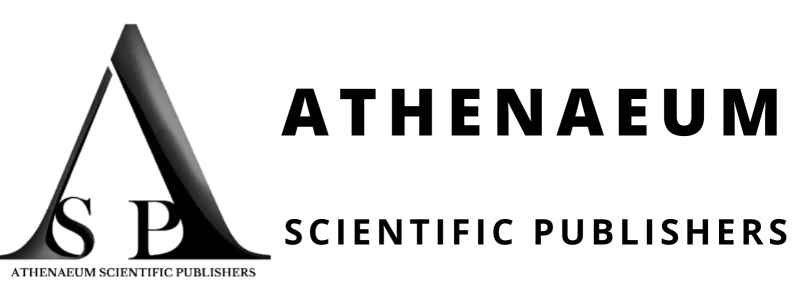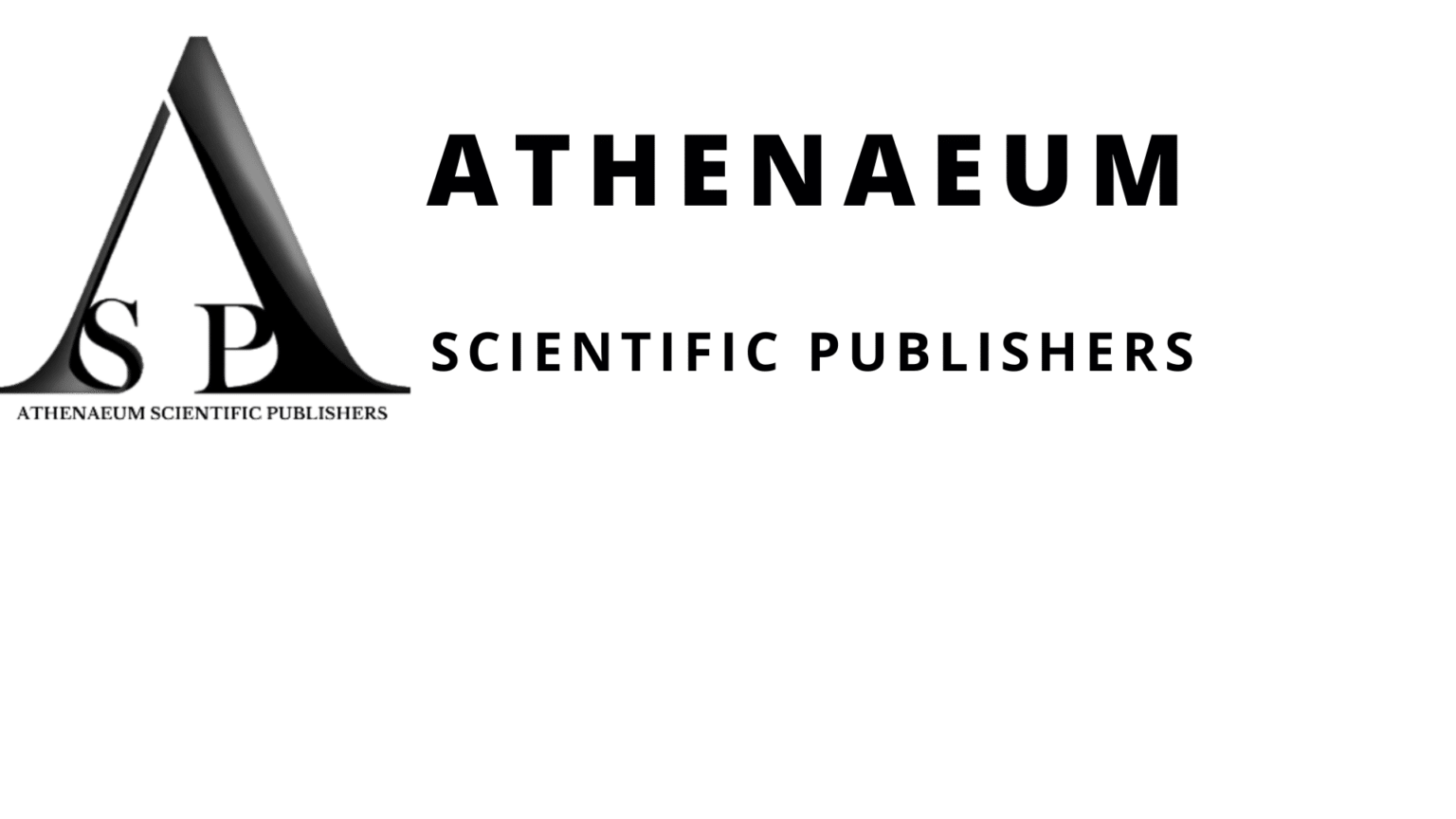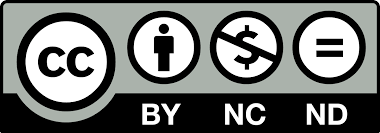Sokaina Chhiti1*, Sara Elloudi1, Fatima Zahra Hashas1, Zakia Douhi1, Meryem Soughi1, Hanane Baybay1, Fatima Zahra Mernissi1
1Department of Dermatology, University Hospital Hassan II Fez, Morocco
*Correspondence author: Chhiti Sokaina, Department of Dermatology, University Hassan II, Morocco; Email: [email protected]
Published Date: 28-05-2023
Copyright© 2023 by Chhiti S, et al. All rights reserved. This is an open access article distributed under the terms of the Creative Commons Attribution License, which permits unrestricted use, distribution, and reproduction in any medium, provided the original author and source are credited.
Abstract
Introduction: Loxoscelism is an under-diagnosed condition due to lack of awareness among practitioners. It is a serious form of araneism that can be strictly cutaneous with variable clinical aspects that can be deadly.
Materials and methods: Five cases were collected over a period of 3 years presenting with envenomation by a supposed spider bite highly suggestive of cutaneous loxoscelism.
Results: We collected five cases of post-spider bite envenomation with an average age of 45 years, predominantly female, of rural origin. The bite occurred in the summer in all cases. The average time to consultation was 2 days. Four patients had felt and located the spider nearby. Two patients had an erysipéloïde placard centred by a necrotic ulceration, while one had post-bite erythema multiforme, one had acute exanthematous pustulosis and one had acute urticaria. Biological tests were normal in all cases. Antihistamines and dermocorticoids were prescribed.
Discussion: This type of envenomation is common in the summer months and in rural areas, with a clear female predominance. It is generally induced by the venom of spiders of the sicariidae family and of the Loxosceles genus. The diagnosis is based on a combination of epidemiological, clinical and biological evidence.
Conclusion: Envenomation by spider bites has been little reported in Morocco until now. This rare cause of necrosis, skin rash deserves to be known by practitioners for an adequate management.
Keywords: Loxoscelism; Prognosis; Haemorrhagic Lesion; Corticosteroid Therapy
Introduction
Loxoscelism is a condition secondary to the bites of spiders, particularly of the genus Loxosceles. This species is ubiquitous but particularly present on the American continent, the Mediterranean rim including Morocco. It is rarely manifested by a visceral attack, but above all by a cutaneous attack ranging from a simple bite to a necrotic envenomation involving the vital and functional prognosis in extreme cases.
Materials and Methods
We report a series of cases collected in our department during 3 years from October 2019 to October 2022. Five cases presented with envenomation by suspected spider bite highly suggestive of cutaneous loxoscelism.
Results
We collected five cases of post spider bite envenomation with a mean age of 45 years, all our cases were female, of rural origin for 3 cases. The bite occurred during the summer in all cases. The average delay of consultation was 2 days. Four patients had felt and located the spider nearby. Pain was present in 3 patients. All patients had a single bite site, resulting in an indurated inflammatory placard centred by an ecchymotic and/or bullous haemorrhagic lesion in two cases (Fig. 1-3), while one case of post-bite erythema multiforme (Fig. 4), one case of acute exanthematous pustulosis and one case of acute urticaria (Fig. 5). Necrotic evolution was noted in 2 patients with secondary ulceration (Fig. 2,3).
The bite was localized to the thigh in two cases, to the face and neck in one case, and a diffuse rash in two cases. A local erysipeloid reaction associated with a febrile state and regional adenopathy was noted in two cases (Fig. 4,5). Facial oedema without signs of severity was noted in one case.
Routine laboratory tests (CBC, platelets, PT, APTT, liver enzymes, renal function) were normal in all cases, CRP was slightly elevated in 3 cases, and the electrocardiogram was normal in 4 cases. No imaging of the thigh was performed for the patients with localised thigh necrosis but mechanical detersion was performed with local care and application of fucidic acid, associated with oral antibiotic for 15 days with remission after 6 weeks for both patients. Antihistamines and dermocorticoids were prescribed for urticaria and erythema multiforme, whereas for acute exanthematous pustulosis, hospitalisation was recommended with a satisfactory evolution. None of our patients had recourse to general corticosteroid therapy (Fig. 6).
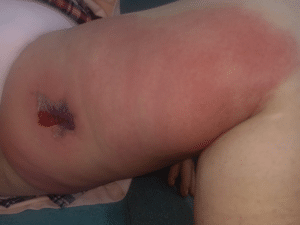
Figure 1: Erysipeloid plaque located on the left thigh centred by the pitting point surmounted by a haemorrhagic bulla.
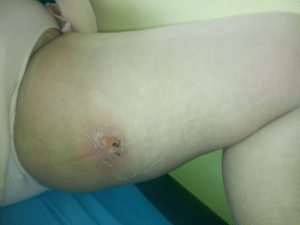
Figure 2: Mechanical removal of skin necrosis.
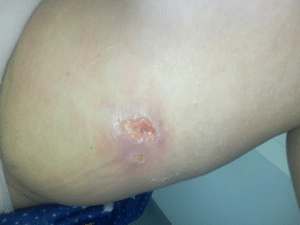
Figure 3: Evolution after two weeks of mechanical detersion.
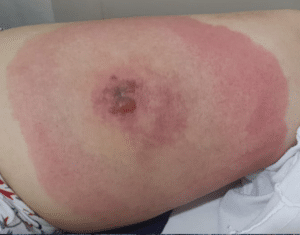
Figure 4: Clinical appearance showing an erysipéloïd placard with central necrosis.
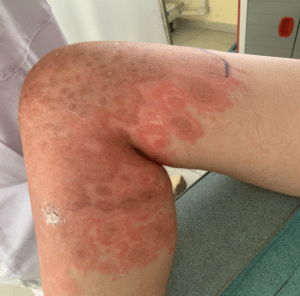
Figure 5: Roundel and pseudo roundel at the level of the lower limbs bilaterally.
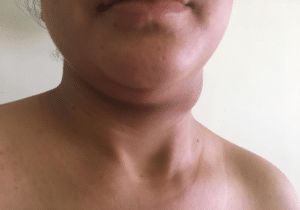
Figure 6: Stinging site in the neck with swelling of the neck and face.
Discussion
Loxoscelism is an under-diagnosed condition due to its lack of recognition by practitioners. It is a severe form of araneism that can be strictly cutaneous with variable aspects ranging from a simple urticarial lesion (macule, papule, urticaria) to a necrotizing ulcerated lesion (necrosis), or a generalized acute exanthematic pustulosis [1,2]. Systemic involvement is rare and mainly haematological (haemolytic anaemia). This type of envenomation is frequent in summer and in rural areas, with a clear female predominance as in our study which can be explained by the fact that Moroccan women in rural areas are mostly housewives and spiders are arachnids that live in temperate and warm regions. Generally, it is induced by the venom of spiders of the sicariidae family and of the genus Loxosceles: these are small ubiquitous spiders that can be found in most temperate and tropical regions around the Mediterranean, a few cases have been described in Tunisia, Libya, Israel, Turkey and Greece [3,4] but rarely reported in Morocco. The diagnosis of certainty is based on the identification of the spider, but in practice the spider is only captured in 13% of cases (the bite being usually painless and rarely noticed) [5]. The diagnosis must then be made on the basis of epidemiological, clinical and biological evidence and after eliminating other causes of skin necrosis or drug-induced toxidermia [6]. In our series, the diagnosis of cutaneous loxoscelism was considered very probable in 3 patients in the absence of formal proof by capture of the spider, and certain in two patients (spider seen and crushed by the patients). We based our decision on a number of arguments: a bite with little or no pain, the region (Mediterranean region), the presence of a single lesion with a negative local necrotic and ulcerated evolution, and a negative etiological assessment. The general management and treatment of any unknown spider bite should be conservative and aimed at alleviating the symptoms. It should include wound cleansing, elevation of the bitten extremity, application of cold compresses, tetanus prophylaxis and administration of analgesics and antihistamines or corticosteroids as in our patient’s case. According to Isbister and Gray, superinfections of spider bite wounds are uncommon (0.9% of cases), so antibiotic therapy is only indicated if there are clear signs of infection and should be based on culture and susceptibility testing [7,8].
Conclusion
We emphasize that this type of spider bite envenomation has been little reported in Morocco until now. This rare cause of necrosis, skin rash deserves to be known by practitioners for an adequate management.
Consent from Patients
The examination of the patient was carried out in accordance with the principles of the Declaration of Helsinki.
Conflict of Interest
The authors have no conflict of interest to declare.
References
- Adya KA, Janagond AB, Inamadar AC. Cutaneous Loxoscelism associated exanthem mimicking acute generalized exanthematous pustulosis. Indian Dermatol Online J. 2022;135:667-8.
- Shahi M, Shahi A, Khademi Z, Zamani AR, Nakhaii AR, Rafinejad J. Loxoscelism: a case report from Bandar Abbas in south of Iran. Hormozgan Medical J. 2021;185:421-7.
- Fetoui NG, Ghariani N, Nabli N, Gammoudi R, Boussofara L, Saidi W, et al. Cutaneous loxoscelism: about 9 Tunisian observations. In Annals of Dermatology and Venereology 2018;145(12)S293.
- Hammami F, Miladi S, Amouri M, Bahloul E, Masmoudi A, Boudaya S, et al. Le loxoscelisme cutané en Tunisie: particularités cliniques et thérapeutiques. InAnnales de Dermatologie et de Vénéréologie. 2019;146(12):A279.
- Leroy-Colavolpe V, Eyraud A, Darrigade AS, Dutkiewicz AS, Taieb A, Milpied B. Loxoscelism arrives in the southwest: about five cases. In Annals of Dermatology and Venereology. 2016;146(12):S344-5.
- Boissiere F, Masson R, Fluieraru S, Vitse J, Dessena L, Lefevre M, et al. Cutaneous loxoscelism, about an exceptional observation of 9 consecutive cases. InAnnales De Chirurgie Plastique Et Esthetique. 2016;61(6):811-9.
- Isbister GK, Gray MR. A prospective study of 750 definite spider bites, with expert spider identification. QJM. 2002;9511:723-31.
- Diaz JH. The global epidemiology, syndromic classification, management and prevention of spider bites. Am J Trop Med Hyg. 2004;712:239-50.
Article Type
Case Report
Publication History
Received Date: 20-04-2023
Accepted Date: 21-05-2023
Published Date: 28-05-2023
Copyright© 2023 by Chhiti S, et al. All rights reserved. This is an open access article distributed under the terms of the Creative Commons Attribution License, which permits unrestricted use, distribution, and reproduction in any medium, provided the original author and source are credited.
Citation: Chhiti S, et al. Cutaneous Loxoscelism On 5 Moroccan Cases. J Dermatol Res. 2023;4(2):1-5.

Figure 1: Erysipeloid plaque located on the left thigh centred by the pitting point surmounted by a haemorrhagic bulla.

Figure 2: Mechanical removal of skin necrosis.

Figure 3: Evolution after two weeks of mechanical detersion.

Figure 4: Clinical appearance showing an erysipéloïd placard with central necrosis.

Figure 5: Roundel and pseudo roundel at the level of the lower limbs bilaterally.

Figure 6: Stinging site in the neck with swelling of the neck and face.
